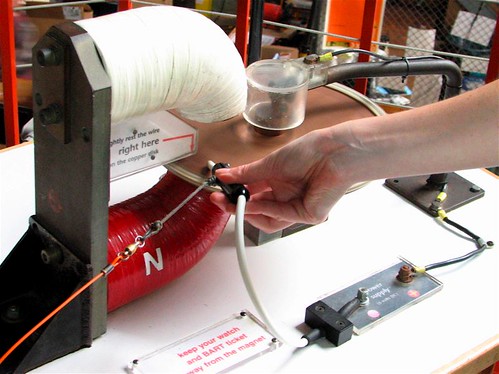A couple of weeks ago, we visited the The Exploratorium, where we saw this giant homopolar motor, labeled “Daisy Dyno.” This is a classic demonstration of a homopolar motor. There’s a giant permanent magnet. In its jaws sits a big copper disk that is free to spin. A low-voltage but high current power supply is provided, where the positive end is hooked to the bearing in the center of the copper disk.
To run the motor, you touch the loose lead from the negative end of the power supply to the edge of the copper disk. A neat little arrow shows you exactly where to touch. The electric current flows from the center of the disk to that point of contact, which is in the direction perpendicular to the magnetic field, which creates a force in the correct direction to cause the disk to spin. In order to help the electric currents move in a fairly straight line between the edge of the disk to the center, the disk has a lot of radial slits cut through it, giving the disk the appearance of a daisy (hence the name) when it’s at rest. In the photo here, it’s moving pretty quickly.
We, of course, are quite fond of motors and magnets and things that spin, and have (so far) written up three under-one-minute science projects that are related: How to build a homopolar motor, how to make the version that spins water instead of a metal disk, and how to make a super-simple directional compass.





Windell,
Where’s teh "Daisy Dyno" video?! Link doesn’t seem to work!
Mark
Mark, I didn’t actually take a video of it, so I’m a little bit confused; did I
accidently leave a broken link to a video somewhere? (I did take some
videos of other things at the Exploratorium, which I plan to post sometime
in the near future.)
—
Windell H. Oskay
drwho(at)evilmadscientist.com
http://www.evilmadscientist.com/
Windell,
Your text says "In the photo here, it’s moving pretty quickly." so I presumed the "classic" link in "This is a classic demonstration of a homopolar" was a link to a video, but alas, no.
Am I allowed to say you should be shot for not taking a video?! (that’s English humour for you!)
More importantly, were you able to test the theory we’ve been discussing about whether relative motion is required between the loose power supply lead and the device?
Cheers,
Mark
Well, in place of the video, let me describe it: You touch the wire to the
disk, and it starts to spin, until you can’t see the slots in the disk anymore.
Its top speed is nowhere near that of the handheld version. The video
would be dreadfully boring– but maybe I’ll take one anyway, next time that
I’m there.
In regards to your other question, I have come to believe that you are
correct that the motor would not work if the wire were rigidly attached to
the edge of the spinning disk.
—
Windell H. Oskay
drwho(at)evilmadscientist.com
http://www.evilmadscientist.com/
Windell,
Cheers for that!
Mark
ps, hope I didn’t offend with the "vidoe" joke
Heh heh. Homo.